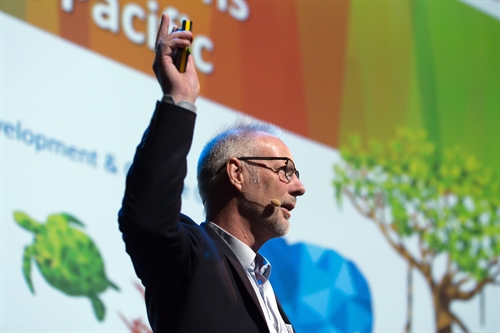“Only 5 percent of funding goes to Nature-based Solutions”
Geoff Wilson from the Asian Development Bank (ADB) gives insight into how they finance Nature-based Solutions (NbS) and how co-benefits can be quantified. The Asian Development helps to fund different projects throughout Asia and ‘pushing’ NbS is high on their agenda, but Geoff Wilson sees that upscaling can be difficult. He points out that currently, only 5 percent of all the funding for water-related infrastructure goes to Nature-based Solutions.
“The problem is how to finance it and to determine who is going to pay for what. We find that there is still a lack of awareness about the advantages of NbS.”
Quantify co-benifits
Most projects have a primary purpose, such as preventing floods, that can justify the investments. If you don’t take into account co-benefits, traditional grey solutions are often financially more attractive. The ADB developed different tools to monetize co-benefits over the lifecycle of an intervention. Wilson: “We always start with big and easy co-benefits, meaning that they are the easiest to quantify and most impactful. There is no need to try and quantify them all.”
[text continues below image]

Qualifying co-benefits doesn’t necessarily imply that Nature-based Solutions always are the preferred option. During a project at the Fiji river, a cost-benefit analysis eventually favored a more traditional approach over mangrove restoration. “The investments did not stack up to the benefits, so in this case, the mangrove option did not happen. The target, in the end, is not Nature-based Solutions but climate adaptation”, he explains.
Attractive loans
To fund NbS the finance expert has little belief in markets, as private companies often can’t monetize (co-)benefits themselves. Wilson, therefore, is convinced that loans should be made as attractive as possible for governments. Developing countries often struggle to get attractive loans. “Therefore the ADB we see it as our mission to help the poorest and most developing countries with getting more favorable loans.”
The KIMA-community doesn’t have to be convinced that Nature-based Solutions have many benefits, like improved biodiversity or increased recreational value. According to Wilson the biggest future challenge for NbS is to quantify those different co-benefits and convince investors. “The fact that it is not easy to quantify doesn’t mean we shouldn’t try. Otherwise, we risk compromising the economic feasibility of projects”, he says.